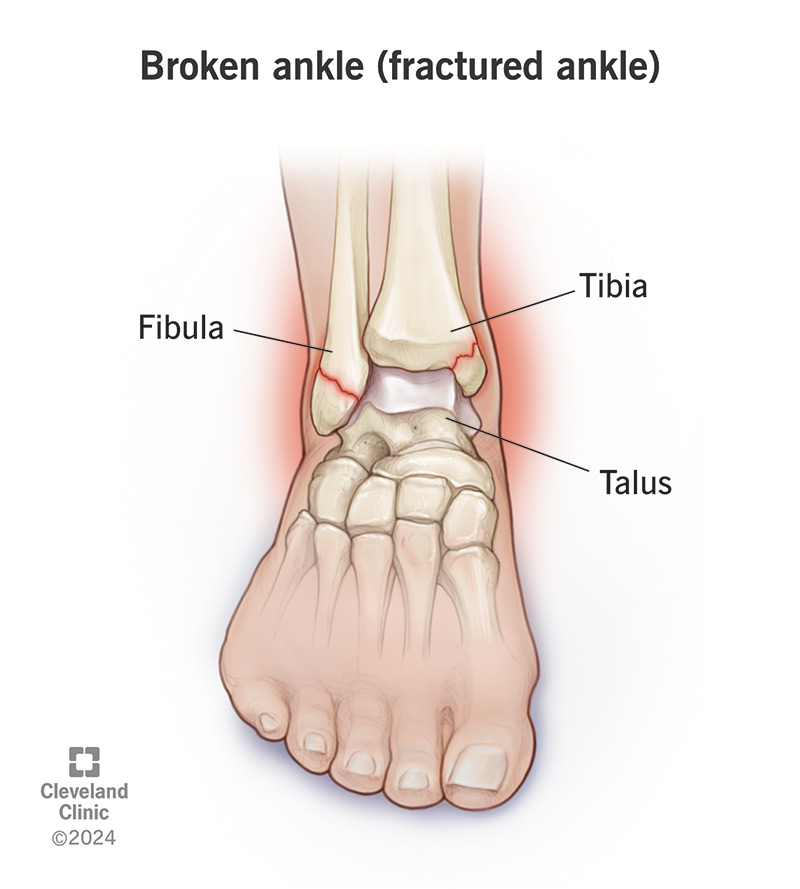Broken ankles are some of the most common bone fractures. The treatment you’ll need will depend on the type of fracture and its severity. Serious fractures require ankle surgery. It can take weeks or months for you to recover from an ankle fracture.
Advertisement
Cleveland Clinic is a non-profit academic medical center. Advertising on our site helps support our mission. We do not endorse non-Cleveland Clinic products or services. Policy

A broken ankle happens when you break one or more bones in your ankle joint. Its medical name is an ankle fracture. It’s one of the most common causes of ankle pain.
Advertisement
Cleveland Clinic is a non-profit academic medical center. Advertising on our site helps support our mission. We do not endorse non-Cleveland Clinic products or services. Policy
Your ankle joint contains three bones:
The lower ends of your fibula and tibia come together and butt up against your talus to form your ankle.
You can break one or more ankle bones at the same time. Serious fractures require ankle surgery. It can take several weeks to a year to fully recover from a broken ankle.
There are several types of fractures, including:
Advertisement
Broken ankle symptoms may include:
It’s not always easy to know if your ankle is broken just by how it feels. Ankle pain is a common symptom that many issues can cause. And if your ankle is broken, you probably won’t know if you’ve broken more than one bone until a healthcare provider can take a look at it.
Getting hit directly in your ankle is the most common cause of fractures. You might fall hard or get hit by something hard enough to break one of your bones. Broken ankle causes include:
A healthcare provider will use several tests to diagnose an ankle fracture, including:
The treatments you’ll need depend on the type and severity of your fracture. Not all broken ankles require surgery. But all ankle fractures need a diagnosis and treatment to make sure they heal properly.
You probably won’t need surgery if you have a stress fracture or if the fracture is non-displaced. That means the bones didn’t move out of place (they’re still lined up correctly). You might need a brace, cast or walking boot to support your ankle while it heals.
More serious fractured ankles need closed reduction or surgery. A closed reduction is when healthcare providers push on the outside of your body to reposition your broken bones. This will correctly align your ankle. Your providers will give you local anesthesia to numb your ankle.
You’ll probably need surgery if the fracture is displaced. Displaced means the bones moved during the injury and are out of place (not in line). A surgeon will insert pins, wires, screws and sometimes plates to repair your ankle and hold the bones in place. They’ll probably perform an open reduction and internal fixation.
Contact your healthcare provider or go to the emergency room if you have:
Healing times from a broken ankle vary. If you didn’t need surgery, your ankle might heal in 12 to 16 weeks. If you had surgery to repair more than one ankle bone, it could be up to two years before your ankle is back to normal.
An ankle fracture will temporarily affect your quality of life, whether or not you need surgery. You may be in a cast or walking boot, taking medication or keeping weight off your ankle for weeks or months. Your broken ankle recovery time can vary based on all these factors. Ask your healthcare provider or surgeon what to expect based on your unique situation.
Advertisement
If you have a minor fractured ankle, you should still be able to walk on it. You might not even know you’ve broken it. But more severe fractures will require you to keep off your foot for several months. After treatment, as your ankle begins to heal, you can gradually return to walking. Don’t resume walking or any other physical activities before your healthcare provider says it’s safe.
If you have a broken ankle, you might get frustrated or anxious waiting for it to heal. But it’s important to remember to take it slow. You can reinjure your ankle if you resume activities too quickly. Talk to your healthcare provider about your concerns. They’ll help you understand everything you need to know about the injury, the treatments you’ll need and what you can expect while you recover.
Advertisement
From sudden injuries to chronic conditions, Cleveland Clinic’s orthopaedic providers can guide you through testing, treatment and beyond.

Last reviewed on 11/14/2025.
Learn more about the Health Library and our editorial process.